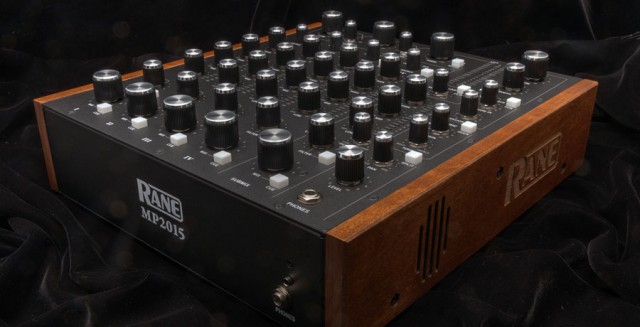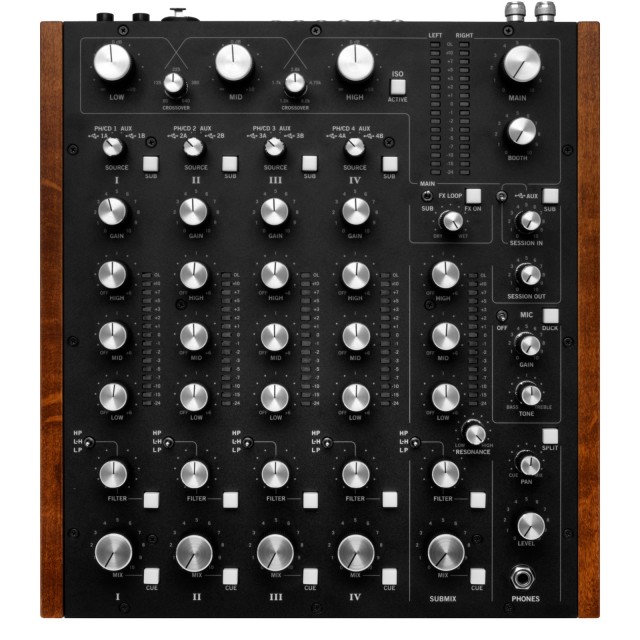
At the 2015 NAMM Show, Rane introduced the MP2015 Rotary Mixer, described as a no-compromise music-mixing performance instrument.
Rane calls their new MP2015 Rotary Mixer the best mixer produced by Rane ever:
There are no compromises in the design. It has the best sound, the best features, the best feel, and the best reliability and durability.

The MP2015 features a classic design, with laser-etched Rane-logo wood side panels, classic spun-aluminum knob caps, 16-segment level peak-hold meters and back-lit push switches.
The MP2015 sports a new compact size and shape for a rotary mixer, with all controls selected, designed and located for effortless professional performance playback. Its size makes it portable and easy to move about.

Sound Quality
The MP2015 uses Audio 4 Pro delta-sigma modulator converters by AKM that meet the highest sound quality standards of recording studios.
The balanced differential audio input converters deliver 116 dB dynamic range, utilizing a built-in modified FIR architecture that minimizes group delay, allowing excellent linear phase response. The 24-bit audio output converters have the same 116 dB dynamic range and sport AKM’s proprietary 24-bit digital filter for better sound quality achieving low distortion characteristics and wide dynamic range.
The differential outputs eliminate the need for AC coupling capacitors further increasing performance. Input and output converters support sample rates of 44.1 kHz, 48 kHz, or 96 kHz. Overall Digital/USB in to Line out, or Line in to Digital/USB out dynamic range is 116 dB (A-weighted), while Line input to Line output dynamic range is a remarkable 113 dB (A-weighted) with vanishingly low THD+N of 0.0009%.
Submix Channel
This unique input channel provides grouping any number of inputs for easy multi-source mixing. It allows one set of controls for all functions verses having to deal with multiple knobs and buttons on multiple channels. Plus this becomes another input simply by activating the SUB button found on the Session In section.
Filters
Each of the four Input channels and the Submix channel feature a unique and exclusive three-position toggle selector-switch. Choose between LP (low-pass), HP (high-pass) or L-H (low-pass, high-pass combo). All have steep 24 dB/octave (4th-order) slopes and are sweepable.
In the LP position the Filter knob sweeps the low-pass frequency from 20 Hz to 20 kHz (CCW to CW). The 12:00 middle position is 635 Hz.
In the HP position the Filter knob sweeps the high-pass frequency from 20 Hz to 20 kHz (CCW to CW). The 12:00 middle position is 635 Hz.
In the L-H position the Filter knob sweeps either the LP or HP filter depending upon rotation direction from center. The 12:00 middle position bypasses both filters giving a flat unaffected response. Rotating the knob from fully counterclockwise to center sweeps the LP filter from 20 Hz to 18 kHz. Rotating the knob from center to fully clockwise sweeps the HP filter from 35 Hz to 20 kHz.
The single Resonance (Q) knob controls the shape of all Input and Submix filters. The range is from flat (Q=0.707) to max peaking (Q=12).
These filters are high resolution, fast and artifact free, with all filter coefficients accurately calculated for the selected sample rate.
Channel Tone Controls
All input channels and the Submix channel have exceptional three-band tone controls characterized by being 12 dB/octave (2nd-order) Linkwitz-Riley, full-cut filters (kill) with selectable crossover points of 150 Hz/6.0 kHz or 300 Hz/3.0 kHz. The crossover points are selected in the user control panel when connected to a computer via the USB ports.
Like the Filters section above, the Tone Control filters are extremely accurate, high resolution, fast and artifact free, with all filter coefficients accurately calculated for the selected sample rate.
Isolator Section
The proprietary three-band output Isolator is a steep 24 dB/octave (4th-order) phase-compensated Linkwitz-Riley design with continuously adjustable low-mid and mid-high crossover points. Like the Tone Controls, these filters are extremely accurate, high resolution, fast and artifact free, with all filter coefficients accurately calculated for the selected sample rate.
Adjustable crossovers allow the artist to match the Isolator to the music being played. Low-mid crossover is adjustable from 80 Hz to 640 Hz. Mid-high crossover is adjustable from 1 kHz to 8 kHz.
Durability
Rane uses heavy 0.048” (1.22 mm) thick cold-rolled steel, electroplated with an aluminum-zinc alloy that makes the chassis rugged and rust proof. The front panel is the same material but extra thick at 0.075” (1.905 mm) to accommodate those moments of DJ exuberance. All metal is finished with a baked-on polyester powder coating.
This finish complies with EU directive 2011/65/EU and contains no Pb, Cd, CrVI, PBB, or PBDE. Additionally it complies with EU directive 2005/717/EC and contains no Deca-BDE. If that is not enough it also complies with EU directive 2006/122/EC and contains no PFOS. What does all that mean? Actually we have no idea but are told you can safely lick and kiss the metal until your tongue and lips blister.
Front panel legends are not screen screened on the surface of the metal but are printed on the reverse side of a Lexan overlay. This prevents wear that eventually would make the printing unreadable. The rugged Lexan is 0.012” (0.305 mm) thick to survive a lifetime of abuse, and it has a matte surface to prevent glare and enhance readability in low or bright lights.
Studio-Quality Phono Preamps
The Phono-CD (or any line-level source) analog input stages feature gold RCA connectors and are true studio-quality preamplifiers providing EMI[2], RFI[3] and transient overvoltage protection against ESD[4]. The circuitry provides low noise, high gain-bandwidth, low harmonic distortion, fast slew rate and high output current. The phono RIAA filter accuracy measures +0.1/-0.2 dB from perfect. Included are 18 Hz high-pass infrasonic (rumble) filters with steep 18 dB/octave slopes and ultrasonic filters beginning rolloff at 50 kHz at a 12 dB/octave rate. A zero-distortion relay selects between CD and Phono operation.
Pro Audio I/O Stages
All analog source input stages have gold RCA connectors along with buffered circuitry that provides EMI, RFI and transient overvoltage protection.
All unbalanced analog outputs have gold RCA connectors along with line-driving circuitry with EMI, RFI and ESD protection as well as on/off transient noise muting transistors.
The differential balanced main outputs exit via the highest quality Neutrik XLR connectors, while the differential balanced booth outputs leave through high-quality Neutrik ¼” TRS (tip-ring-sleeve) connectors. Both outputs have EMI, RFI and ESD as well as on/off transient noise muting transistors.
All line-level analog input and output stages utilize an amplifier design exhibiting very low input voltage noise with high gain-bandwidth-product and high slew rate. The line-driving output stage exhibits no deadband crossover distortion, large output voltage swing, excellent phase and gain margins, low open-loop high frequency output impedance and symmetrical source and sink AC frequency performance.
Mic Preamp
The superior microphone preamplifier is a high-performance current-feedback instrumentation design manufactured by the world leader in pro audio analog circuits, THAT Corporation, having lower noise at low gains, wider bandwidth, higher slew rate, lower distortion, and lower supply current than other designs. Transient overvoltage protection is provided along with selectable +48 volt phantom power.
Headphone Amps
The stereo headphone amplifiers use a unique Maxim Integrated DirectDrive® architecture that eliminates the need for large DC-blocking capacitors. The amplifiers deliver up to 70mW per channel into a 16 ? load or 130 mW into a 32 ? load and have low 0.009% THD+N. The design includes ESD protection on the headphone outputs along with short-circuit and thermal-overload protection. Comprehensive anti-click-and-pop circuitry suppresses audible clicks and pops on startup and shutdown. Complementing the headphone amplifiers is the versatile cueing system utilizing Rane’s proprietary Split Cue technology.
Digital Signal Processing (DSP)
All digital computations are done by a Texas Instruments 32-bit floating point digital signal processor running at 44.1 kHz, 48 kHz or 96 kHz.
All S/PDIF transceivers are Texas Instruments pro audio devices with exceptional receiver sample rate converters.
Dual USB Ports
Dual USB ports provide for simultaneous connection of two computers, enabling back-to-back sets between laptop DJs running different software without compromise or interruption—no easy feat.
The USB ports are 100% class compliant, allowing hook-up to any Mac OSx device without the need for an additional driver.
The included high-performance ASIO driver runs most Windows DAW and DJ software.
MIDI end points are class compliant with both OSx and Windows devices.
Each port supports 10 playback and 14 records channels. This lets most DAW programs simultaneously record all four decks, the Submix, the Session input and the Main mix.
For more information, see the Rane site.

want, how much tho?
I think I read somewhere $2200 USD
time to join rotary club?
If only they had released this 15-20 years back, instead of that two piece that only clubs and rich kids could afford.
They say ‘pro quality I/O’ then give RCA jacks? Nice build quality by the looks, but an odd feature set.
of course !! its a dj mixer what do you expect?
Nothing is new ! http://www.electronique-spectacle.com/djr400.php
Would love to see a simple (and cheaper) 2 source version of this for phono
Are there people that think knobs are better to use on a mixer, instead of sliders?
I’m just finding that hard to believe…
I hear you… still looks sexy though.
YES!
I think its easier to do fine adjustments like filter sweeps and eq and effects with a knob. Which is what the mixer is for. Faders are good for on/off – In/out type effects IMO.
when i saw this, it reminded me of a video of derrick may playing at moma ps1: https://www.youtube.com/watch?v=GXvoVB-Dpjk
oh man Ive been waiting for them to do something like this. And I just bought the 2016 with the eq expansion a few days after xmas!